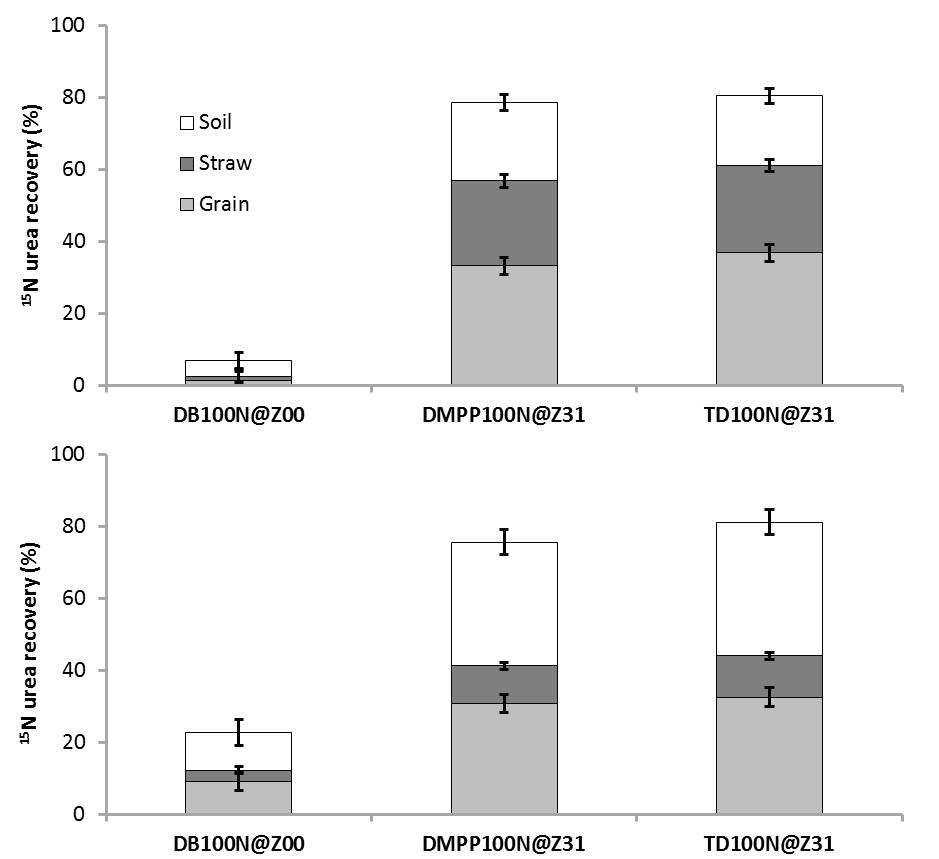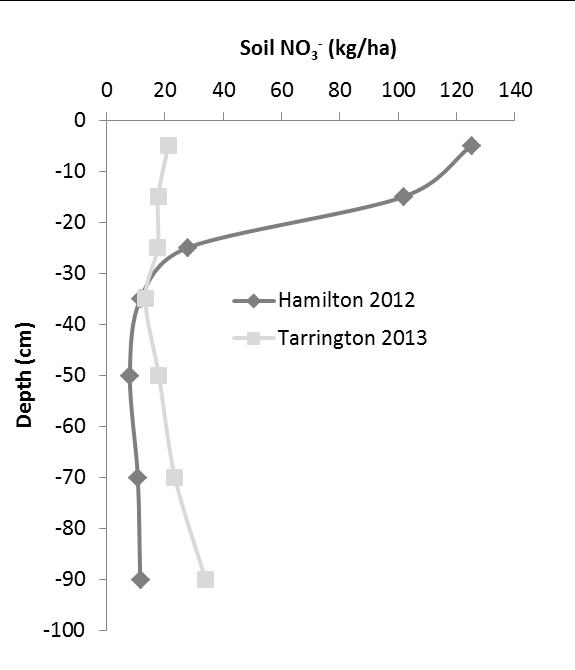Nitrogen management in waterlogged crops
Author: Rob Harris (Department of Economic Development, Jobs, Transport and Resources - Hamilton) | Date: 30 Jul 2015
Take home messages
- Topdressing N around first node of wheat growth improves crop N uptake compared with deep banding N at sowing.
- Synchronising N fertiliser application with peak crop N demand improves crop fertiliser use and reduces gaseous N losses from waterlogged soil.
- DMPP (Entec®) topdressed at first node did not enhance crop N fertiliser uptake or reduce N2O losses, compared with the equivalent rate of untreated urea N.
Background
As cropping systems have intensified there has been an increased reliance on nitrogen (N) fertiliser, now constituting the single largest variable cost for most grain growers. The challenge for growers is supplying the right amount of N at the right time and place to meet crop demand and optimise yield and quality, without over supplying N and reducing profit. Recent research has shown that applying N fertiliser to waterlogging prone soil in southwest Victoria can lead to high rates of N lost as gas to the atmosphere (Harris et al. 2013); making it more difficult to judge the appropriate rate, timing and placement of N fertiliser to crops growing in waterlogging prone soil.
When oxygen supply diminishes under waterlogging, N can be lost to the atmosphere largely in the form of either nitrous oxide (N2O) or di-nitrogen (N2) gas. The form of N gas is influenced by soil water content; N2 tends to be lost from highly waterlogged soil, while N2O from less saturated soil. The rate of gaseous N loss is also driven by soil carbon (C) and soil nitrate (NO3-) supply, as well as soil temperature (Dalal et al. 2003). This paper summarises findings from field experiments measuring crop N fertiliser uptake and N2O losses from crops in southwest Victoria, providing insights into N management for crops growing in waterlogging prone soil.
Methodology
Replicated field experiments were undertaken at Hamilton on raised beds, and Tarrington on conventional flat seedbeds in southwest Victoria, to investigate the effects of deep banding versus topdressing N fertiliser on crop N uptake and N2O losses. Conventional untreated urea and DMPP (3,4-Dimethylpyrazole phosphate, Entec®) coated to urea; a nitrification inhibitor designed to delay the conversion of ammonium (NH4+) to nitrite (NO2-), thus keeping N in a form less prone to losses as N2O (Weiske et al. 2001) or leached beyond the root zone (Di and Cameron 2012), were investigated. At each site, pre-sowing (100 cm depth) profile soil N was determined and static chambers were used to measure N2O losses. 15N labelled urea fertiliser, either treated with DMPP or untreated, was applied to quantify the amount of fertiliser N recovered by the crop. See Table 1 for site and crop management details.
Table 1: Soil type, recent site history, sowing dates and fertiliser management for respective treatments applied to wheat cv. Bolac sown at Hamilton in 2012 and Tarrington in 2013, in southwest Victoria.
| HistoryA | Sowing date | Treatment | Fert. at sowingB | Additional N | ||
| kg/ha | Appl. date | Appl. method | Urea N amount kg N/ha | |||
| Hamilton 2012 (raised bed) | ||||||
|---|---|---|---|---|---|---|
| fallow |
30 May |
ON | DSP 88 | - | - | 0 |
| DB100N@Z00 | DSP 88 | 31 May | DBC | 100 | ||
| DMPP100N@Z31 | DSP 88 | 10 Sep | TD | 100 | ||
| TD100N@Z31 | DSP 88 | 10 Sep | TD | 100 | ||
| Tarrington 2013 (flat seedbed) | ||||||
| canola |
9 May |
ON | DSP 88 | - | - | 0 |
| DB100N@Z00 | DSP 88 | 9 May | DBC | 100 | ||
| DMPP100N@Z31 | DSP 88 | 19 Aug | TD | 100 | ||
| TD100N@Z31 | DSP 88 | 19 Aug | TD | 100 | ||
AManagement in the previous year, BBasal fertiliser with the seed at sowing, DSP double superphosphate, DB fertiliser deep banded approximately C10 below the seed at sowing, TD topdressed, Z00 sowing, Z31 first node stage of wheat growth.
Results and discussion
15N labelled urea recovery
To determine the fate of applied fertiliser N, isotopic labelled (15N) urea was used at Hamilton and Tarrington, to track the movement of N application. At crop maturity the amount of 15N in the soil (0-40cm) and crop (grain and straw) was measured and the amount not recovered assumed to be lost to the atmosphere or deeper into the soil.
Topdressing N resulted in better recovery of applied N than deep banding (Figure 1). The poor recovery of deep banded 15N urea was probably due to high winter rainfall and longer periods of waterlogging providing opportunity for gaseous or drainage losses before the crop had reached peak growth and demand for N in spring.
Despite very wet surface soil at the Tarrington site at the time of topdressing with 15N urea, a surprising amount of N was recovered by the crop. In comparison, research by CSIRO in Western Australia reported only 10 per cent of the applied N was recovered by the crop when applied the day after waterlogging ceased, compared with 55 per cent recovery when the same amount of N was applied three weeks after waterlogging; providing more time for roots to recover and consequently greater uptake of N fertiliser (Paterson 2007).
Crop recovery of 15N labelled urea was not enhanced by the use of DMPP, implying no increased retention of the applied N for crop uptake or improved yield over conventional urea. While other studies have shown a greater retention of NH4- in response to the application of DMPP (Weiske et al. 2001; Pfab et al. 2012), few have demonstrated improved plant N uptake and yield.

Figure 1: Percent recovery of 15N labelled urea fertiliser in the crop and in the soil (0-40cm) at Hamilton and Tarrington in southwest Victoria. Bars indicate least significant difference at (P<0.001).
N2O losses
Total losses of N2O as a proportion of applied N fertiliser are often less than 1 per cent in dryland cropping systems, but may be higher during prolonged waterlogging events, especially in acidic soils with high clay content subsoil restricting drainage. Deep banding urea N at sowing resulted in higher N2O losses compared with topdressing in season, with losses from topdressing only slightly higher than the 0N treatment at both sites (Figure 2). Topdressing DMPP at first node did not reduce N2O losses, compared with the equivalent rate of untreated urea N (Figure 2).
N2O losses were higher at Hamilton compared with Tarrington possibly for two reasons; (1) greater concentrations of soil NO3- at the beginning of the growing season at Hamilton compared with Tarrington (an extra 152 kg NO3-/ha, Figure 3); and/or (2) raised beds at Hamilton prevented the soils from becoming wet enough to produce N2, instead producing more N2O, compared with the wetter Tarrington site that may have produced more N2 than N2O in the absence of surface drainage.

Figure 2: N2O losses over the growing season at Hamilton and Tarrington in southwest Victoria.

Figure 3: Distribution of soil NO3- to 100 cm depth in autumn, before sowing at Hamilton 2012 and Tarrington 2013, in southwest Victoria.
Conclusions
- Topdressing 15N urea fertiliser around first node improved crop N fertiliser uptake compared with deep banding 15N at sowing.
- Topdressing urea N around first node of wheat growth reduced N2O losses compared with deep banding urea at sowing.
- DMPP (Entec®) topdressed at first node did not enhance crop N fertiliser uptake or reduce N2O losses, compared with the equivalent rate of untreated urea N.
- Peak crop demand for N occurs between the end of tillering and ear emergence, supplying N fertiliser at the beginning of this period of growth will enhance N fertiliser uptake and minimise losses.
References
Dalal RC, Weijin W, Robertson GP, Parton WJ (2003). Nitrous oxide emission from Australian agricultural lands and mitigation options: a review. Australian Journal of Soil Research 41, 165-195.
Di HJ, Cameron KC (2012) How does the application of different nitrification inhibitors affect nitrous oxide emissions and nitrate leaching from cow urine in grazed pastures. Soil Use and Management 28, 54-61.
Harris RH, Officer SJ, Hill PA, Armstrong RD, Fogarty KM, Zollinger RP, Phelan AJ, Partington DL (2013) Can nitrogen fertiliser and nitrification inhibitor management influence N2O losses from high rainfall cropping systems in South Eastern Australia? Nutrient Cycling in Agroecosystems 95, 269–285.
Paterson J (2007) Unravelling the roots of waterlogged wheat. Farming Ahead 180, 44-45.
Pfab H, Palmer I, Buegger F, Fiedler S, Muller T, Ruser R (2012) Influence of a nitrification inhibitor and placed N fertilization on N2O fluxes from a vegetable cropped loamy soil. Agriculture, Ecosystems and Environment 150, 91-101.
Weiske A, Benckiser G, Herbert T, Ottow JCG (2001) Influence of the nitrification inhibitor 3,4-dimethylppyrazole phosphate (DMPP) in comparison to dicyandiamide (DCD) on nitrous oxide emissions, carbon dioxide fluxes and methane oxidation during 3 years of repeated application in field experiments. Biology and Fertility of Soils 34, 109-117.
Acknowledgements
We thank the federal Dept. of Agriculture, the Grains Research and Development Corporation and the Victorian State Government for funding.
Contact details
Rob Harris
Victorian Dept. Economic Development, Jobs, Transport and Resources
PO Box 105, Hamilton Vic, 3300
(03) 55730963, 0409965865
rob.harris@ecodev.vic.gov.au
GRDC Project Code: DAV00125,
Was this page helpful?
YOUR FEEDBACK
